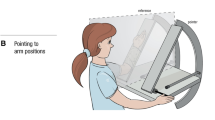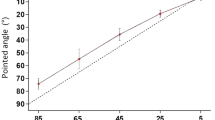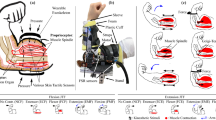Abstract
Changes in the position of the head and neck have been shown to introduce a systematic deviation in the end-point error of an upper limb pointing task. Although previous authors have attributed this to alteration of perceived target location, no studies have explored the effect of changes in head and neck position on the perception of limb position. This study investigated whether changes in head and neck position affect a specific component of movement performance, that is, the accuracy of joint position sense (JPS) at the elbow. Elbow JPS was tested with the neck in four positions: neutral, flexion, rotation and combined flexion/rotation. A target angle was presented passively with the neck in neutral, after a rest period; this angle was reproduced actively with the head and neck in one of the test positions. The potential effects of distraction from head movement were controlled for by performing a movement control in which the head and neck were in neutral for the presentation and reproduction of the target angle, but moved into flexion during the rest period. The absolute and variable joint position errors (JPE) were greater when the target angle was reproduced with the neck in the flexion, rotation, and combined flexion/rotation than when the head and neck were in neutral. This study suggests that the reduced accuracy previously seen in pointing tasks with changes in head position may be partly because of errors in the interpretation of arm position.


Similar content being viewed by others
References
Bennell K, Wee E, Crossley K, Stillman BC, Hodges P (2005) Effects of experimentally induced anterior knee pain on knee joint position sense in healthy individuals. J Orthop Res 23(1):46–53
Berger M, Lechner-Steinleitner S, Kozlovskaya I, Holzmuller G, Mescheriakov S, Sokolov A, Gerstenbrand F (1998) The effect of head-to-trunk position on the direction of arm movements before, during, and after space flight. J Vestib Res 8:341–354
Biguer B, Donaldson IM, Hein A, Jeannerod M (1988) Neck muscle vibration modifies the representation of visual motion and direction in man. Brain 111:1405–1424
Blouin J, Okada T, Wolsley C, Bronstein A (1998) Encoding target-trunk relative position: cervical versus vestibular contribution. Exp Brain Res 122:101–107
Bresciani JP, Blouin J, Popov K, Bourdin C, Sarlegna F, Vercher JL, Gauthier GM (2002) Galvanic vestibular stimulation in humans produces online arm movement deviations when reaching towards memorized visual targets. Neurosci Lett 318:34–38
Caminiti R, Johnson PB, Galli C, Ferraina S, Burnod Y (1991) Making arm movements within different parts of space: the premotor and motor cortical representation of a coordinate system for reaching to visual targets. J Neurosci 11:1182–1197
Cohen LA (1961) Role of eye and neck proprioceptive mechanisms in body orientation and motor coordination. J Neurophysiol 24:1–11
Darling WG, Hondzinski JM, Harper JG (2000) Gaze direction effects on perceptions of upper limb kinesthetic coordinate system axes. Exp Brain Res 135:360–372
Day BL, Severac Cauquil A, Bartolomei L, Pastor MA, Lyon IN (1997) Human body-segment tilts induced by galvanic stimulation: a vestibularly driven balance protection mechanism. J Physiol 500:661–672
Engel KC, Flanders M, Soechting JF (2002) Oculocentric frames of reference for limb movement. Arch Ital Biol 140:211–219
Fookson O, Smetanin B, Berkinblit M, Adamovich S, Feldman G, Poizner H (1994) Azimuth errors in pointing to remembered targets under extreme head rotations. Neuroreport 5:885–888
Gentilucci M, Jeannerod M, Tadary B, Decety J (1994) Dissociating visual and kinesthetic coordinates during pointing movements. Exp Brain Res 102:359–366
Guerraz M, Blouin J, Vercher JL (2003) From head orientation to hand control: evidence of both neck and vestibular involvement in hand drawing. Exp Brain Res 150:40–49
Gurfinkel VS, Popov KE, Smetanin BN, Shlykov VY (1989) Changes in the direction of vestibulomotor response in the course of adaptation to protracted static head turning in man. Neurophysiol 21:159–164
Henriques DY, Medendorp WP, Gielen CC, Crawford JD (2003) Geometric computations underlying eye-hand coordination: orientations of the two eyes and the head. Exp Brain Res 152:70–78
Janwantanakul P, Magarey ME, Jones MA, Dansie BR (2001) Variation in shoulder position sense at mid and extreme range of motion. Arch Phys Med Rehabil 82:840–844
Jeannerod M (1991) A neurophysiological model for the directional coding of reaching movements. In: Paillard J (ed) Brain and space. Oxford University Press, Oxford, pp 49–69
de Jong PT, de Jong JM, Cohen B, Jongkees LB (1977) Ataxia and nystagmus induced by injection of local anesthetics in the neck. Ann Neurol 1:240–246
Knox JJ, Coppieters MW, Hodges PW (2003) Galvanic vestibular stimulation alters elbow proprioception. In: Lord SR, Menz HB (eds) Conference of the International Society for Postural and Gait Research, Sydney, Australia, 61pp
Manzoni D, Pompeiano O, Stampacchia G (1979) Cervical control of posture and movements. Brain Res 169:615–619
Mars F, Honore J, Richard C, Coquery J-M (1998) Effects of an illusory orientation of the head on straight-ahead pointing movements. Curr Psychol Cognit 17:749–762
Mars F, Archambault PS, Feldman AG (2003) Vestibular contribution to combined arm and trunk motion. Exp Brain Res 150:515–519
Mittelstaedt H (1998) Origin and processing of postural information. Neurosci Biobehav Rev 22:473–478
Prablanc C, Echallier JF, Komilis E, Jeannerod M (1979) Optimal response of eye and hand motor systems in pointing at a visual target. I. Spatio-temporal characteristics of eye and hand movements and their relationships when varying the amount of visual information. Biol Cybern 35:113–124
Roll JP, Roll R, Velay J-L (1991) Proprioception as a link between body space and extra-personal space. In: Paillard J (ed) Brain and space. Oxford University Press, Oxford, pp 112–132
Rossetti Y, Tadary B, Prablanc C (1994) Optimal contributions of head and eye positions to spatial accuracy in man tested by visually directed pointing. Exp Brain Res 97:487–496
Taylor RA, Marshall PH, Dunlap RD, Gable CD, Sizer PS (1998) Knee position error detection in closed and open kinetic chain tasks during concurrent cognitive distraction. J Orthop Sports Phys Ther 28:81–87
Voisin J, Chapman CE (2003) An egocentric frame of reference for haptic processing of macrogeometric shape. In: Neuroscience Proceedings, New Orleans, LA
Wardman DL, Taylor JL, Fitzpatrick RC (2003) Effects of galvanic vestibular stimulation on human posture and perception while standing. J Physiol 551:1033–1042
Werner H, Wapner S, Bruell JH (1953) Experiments on sensory-tonic field theory of perception: VI. Effect of position of head, eyes and of object on position of the apparent median plane. J Exp Psychol 46:293–299
Wierzbicka MM, Gilhodes JC, Roll JP (1998) Vibration-induced postural posteffects. J Neurophysiol 79:143–150
Acknowledgments
PH is supported by the National Health and Medical Research Council of Australia.
Author information
Authors and Affiliations
Corresponding author
Rights and permissions
About this article
Cite this article
Knox, J.J., Hodges, P.W. Changes in head and neck position affect elbow joint position sense. Exp Brain Res 165, 107–113 (2005). https://doi.org/10.1007/s00221-005-2293-y
Received:
Accepted:
Published:
Issue Date:
DOI: https://doi.org/10.1007/s00221-005-2293-y




